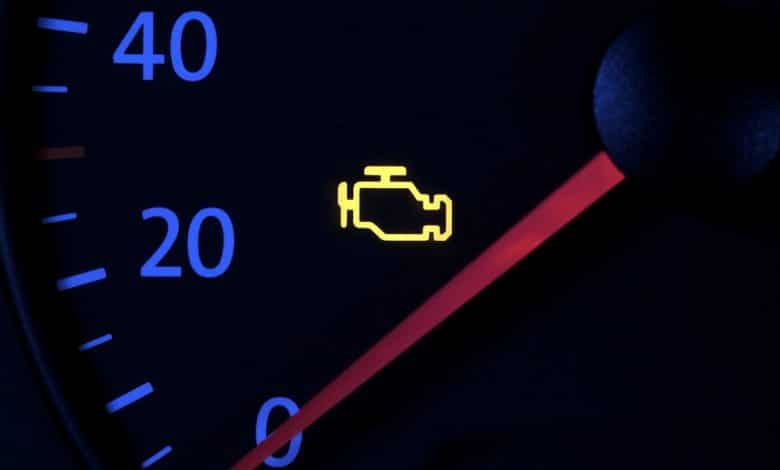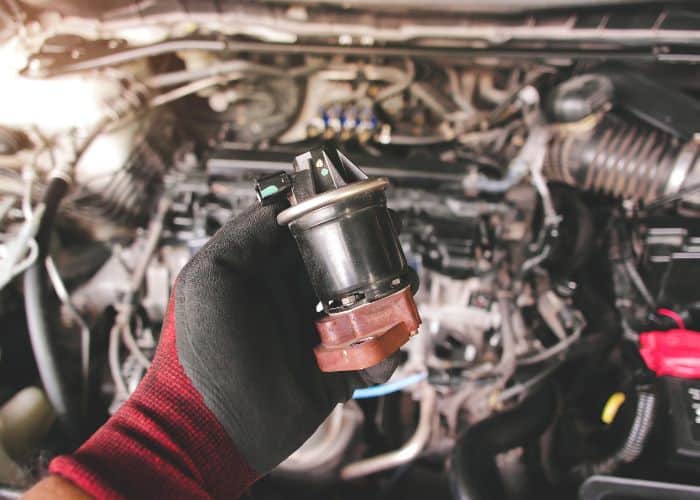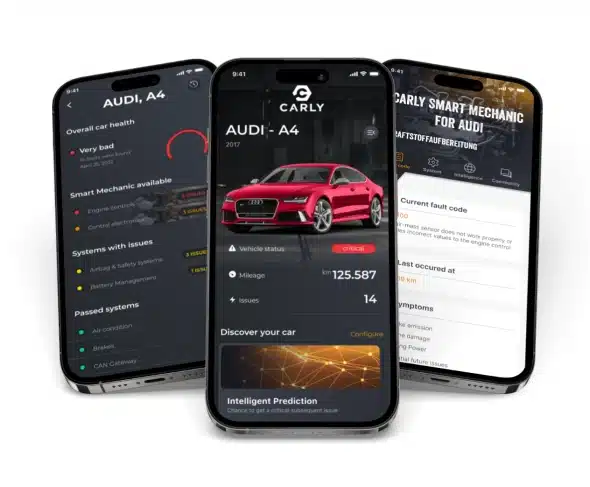Your Audi check engine light comes on and you are wondering what to do? This article explains the most common reasons for the light coming on, gives practical tips on how you should react in the short and long term, and how you can solve problems without expensive workshop visits.
The most important facts at a glance
- The engine control light (ECL) can indicate a range of problems, from simple ones such as a loose fuel filler cap to serious faults in the exhaust or fuel system.
- An OBD diagnostic device such as Carly can be used for self-testing to read fault codes and allows non-professionals to quickly identify problems and minimize workshop visits.
- If the MKL lights up, the vehicle should be taken to the workshop promptly or immediately, depending on the situation, in order to prevent further damage and avoid higher repair costs.
Audi check engine light: a warning signal that requires attention

The engine control light (ECL) is an important indicator light in your Audi. If the engine control light is illuminated, it indicates yellow or orange and a fault in the engine control unit. This could be a minor problem, such as a loose gas cap, or something more serious that requires immediate attention. But what exactly does it mean when the engine control light is on or flashing?
GAIN MORE CONTROL OF YOUR CAR WITH THE CARLY FEATURES
Check the exact pricing of Carly for your car brand!

Fast International Shipping with DHL

14 days adaptor return policy

Excellent customer support

Lifetime warranty in the hardware
SEEN IN
If the MKL lights up, your vehicle’s on-board diagnostics have stored an error. This error may become visible when you start your engine. The MKL should normally go out after starting the engine. However, if it lights up continuously, this indicates an existing fault. A permanently illuminated MKL does not mean immediate danger, but it should not be ignored. This means that you should visit a workshop soon to determine the cause and rectify the problem.
However, if the MKL flashes, this indicates a more urgent problem and you should take immediate action.
Location of the check engine light on various Audi models
If you’ve ever wondered exactly where to find the check engine light in your Audi, you’re not alone. This important light, which is part of the vehicle diagnostic system, plays a crucial role in informing the driver of problems or malfunctions in the engine compartment. To make your search easier, we have put together a clear table showing the general location of the engine indicator light for various Audi models. From the A3 range to the R8, here is a quick overview to help you locate this important symbol on your dashboard.
| Audi model | General location of the engine indicator light |
|---|---|
| Audi A3 | In the instrument cluster, among other warning lights. |
| Audi A4 | Within the main instrument cluster, usually near the speedometer. |
| Audi A6 | On the dashboard in the instrument cluster, close to the rev counter. |
| Audi Q3 | Part of the digital dashboard display, below the vehicle status symbols. |
| Audi Q5 | In the instrument cluster, near other monitoring lights. |
| Audi Q7 | Digital display dashboard, integrated with the vehicle system warnings. |
| Audi TT | On the main instrument display, under the car’s operating symbols. |
| Audi R8 | Central part of the digital dashboard, together with other warning indicators. |
Typical reasons when the MKL lights up at Audi

There are various reasons why the MKL could light up in your Audi. Some of the most common are problems with the EGR valve, the lambda sensor or the ignition system.
The EGR valve is an important part of your vehicle’s emissions system. However, it can wear out over time and lead to problems. Some of the most common problems are:
- Coking due to age or mileage
- Software updates
- Oil leaks
- Damaged seals or sensors
- Neglected service
Any of these problems can cause the MKL to light up.
The lambda sensor measures the oxygen content in your car’s exhaust gas. A defective lambda sensor can manifest itself in the following symptoms:
- uneven idling
- Increased fuel consumption
- Lack of engine power
- Activation of the MKL (engine control light)
Malfunctions in the ignition system, such as damage to ignition coils, can also lead to jerking, stuttering and misfiring and are a common cause of the MKL lighting up.
First steps after lighting up
If the MKL lights up in your Audi, this can be worrying. But don’t worry, there are some initial steps you can take to fix the problem.
First, you should try switching off the engine once and restarting it. This can help to check whether the problem persists. It could be that the MKL lights up due to a temporary problem and goes out after the engine is restarted. Another simple step is to check the fuel filler cap. A loose fuel filler cap can actually cause the MKL to light up. This is because a leaking fuel filler cap can affect the pressure in the fuel system. Make sure that the lid is firmly closed.
However, if the MKL remains illuminated after these steps, you should visit a workshop. A constantly illuminated MKL may indicate a less urgent problem, but it should be checked soon to avoid possible damage to the engine.
Diagnostics with Carly OBD: Read fault codes easily
It is often difficult to understand exactly what the problem is when the MKL lights up. This is where the Carly OBD tool comes into play. This innovative diagnostic tool can help you to read out the fault codes that activate the MKL.

With the Carly app you can:
- Read out error codes
- Gain access to real-time parameters
- Retrieve information about the vehicle history
- Use coding options
Although the interpretation of fault codes can be complicated for non-experts, the Carly app offers user guidance and support that enables even non-experts to carry out diagnoses without expensive workshop visits by using the device.
Advantages of using an OBD tool compared to a workshop
Using an OBD tool such as Carly offers a number of advantages over traditional workshop visits. One of the biggest advantages is the potential cost savings. By reading out the fault memory with an OBD tool, you can reduce the need for a professional diagnostic device in the workshop, which can lead to considerable cost savings.
In addition, an OBD tool offers you the option of reading out fault memories at any time, independently and without having to wait for workshop appointments and opening hours. This allows you to make informed decisions and can help avoid costly repairs in the workshop.
Even non-professionals can easily gain access to the vehicle’s error codes by using an OBD tool, without having to use special devices for different car brands.
Instructions: How to read error codes with Carly OBD
Now that you know the benefits of using an OBD tool, you may be wondering how to read fault codes with the Carly OBD tool. Don’t worry, it’s a simple process that anyone can do.
First you need to download the Carly app from the App or Play Store. The required license costs are between 21 and 80 euros per year, depending on the subscription. The Carly OBD adapter that you need costs a one-off fee of 59.90 euros and is plugged into the OBD2 socket of your vehicle. As soon as the adapter is connected, the connection between your smartphone and the adapter is established automatically via Bluetooth Low Energy (BLE).
Once the connection has been established, you can open the Carly app and start reading. The error codes read out are decoded by the Carly OBD adapter and appear as a specific code consisting of letters and numbers, which you can look up using an error list.
You can then obtain a detailed analysis of the error codes in the Carly app, including a description of the problem and possible causes.
Common defects and their symptoms
There are a number of faults that can activate the MKL. These range from problems with the engine itself to faults in supporting systems. Typical symptoms of a malfunction are fluctuations in the engine speed when idling and jerking of the vehicle.
It is important to note that a permanent illumination of the MKL can indicate increased emissions or fuel consumption, even if the vehicle is otherwise driving normally. This underlines the importance of quickly diagnosing and rectifying problems that have activated the MKL.
Defects in the exhaust system
Some of the most common causes of the MKL lighting up are defects in your vehicle’s exhaust system. These can be problems with the exhaust gas recirculation valve (EGR valve) or the catalytic converter, for example.
The EGR valve plays an important role in reducing nitrogen oxides in your car’s exhaust gases. However, if it is defective, it can lead to various symptoms, including:
- Engine judder
- Idle fluctuations
- Power loss
- increased nitrogen oxide values in the exhaust gas
In addition, problems with the catalytic converter, such as a reduction in its conversion efficiency, can also cause the MKL to light up.
Leaks in the exhaust tract, which can be detected by pressure sensors, are also a possible reason for the MKL to light up.
Malfunctions in the fuel system
Faults in the fuel system can also cause the MKL to light up. These include problems such as a clogged fuel filter, leaking or clogged injectors and fuel pressure that is too low or too high.
A clogged fuel filter can cause the engine to start poorly or not at all, engine performance to drop and the car to jerk when accelerating. Leaking or clogged injectors can also cause a number of problems, including starting problems, increased fuel consumption and poor exhaust emissions.
In addition, low fuel pressure can cause the engine to run lean and tend to misfire, while too high fuel pressure can cause the engine to run rough and consume too much fuel.
Electrical and sensory sources of error
In addition to mechanical problems, electrical and sensor faults can also cause the MKL to light up. These include defects in the mass air flow sensor and the camshaft sensors.
A defective mass air flow sensor can lead to insufficient engine power, a slow-responding signal and even engine standstill. Defective camshaft sensors can also cause a variety of symptoms, including illuminated MKL, fault codes, emergency running program, increased fuel consumption, starting problems, speed fluctuations and loss of power. It is important to note that both the mass air flow sensor and the camshaft sensors are important parts of the engine management system and their proper functioning is essential for the smooth operation of the engine.
Recommended action if the engine control light is illuminated

It is important to emphasize that ignoring the illuminated MKL can lead to serious breakdowns and result in high repair costs. It is therefore advisable to take action as soon as possible if the MKL lights up.
Early detection of problems using an OBD tool can prevent major damage and expensive repairs. If the MKL lights up continuously, you should visit a workshop. During this time, it is normally still possible to operate the vehicle. However, it is advisable to follow the instructions in the owner’s manual and only drive as far as necessary to reach a workshop.
If the MKL flashes very quickly, this indicates a serious fault and the vehicle should be taken to the workshop immediately or towed away if necessary.
When is a trip to the workshop unavoidable?
There are certain situations in which a trip to the workshop is unavoidable. A rapid flashing of the MKL is one such case. This indicates a serious defect that requires immediate attention.
If the MKL flashes quickly, you should take the vehicle to the workshop immediately to avoid consequential damage. It is also important that you do not try to fix the problem yourself to avoid further damage.
Even if the MKL lights up continuously, you should visit a workshop. Even if it is possibly a less urgent problem, it should still be checked to avoid possible damage to the engine.
Possible repairs and their costs
The costs for repairs in connection with the MKL can vary. The cost of reading out the fault memory in a workshop, for example, is between 20 and 80 euros and the process takes less than 30 minutes.
Some specific interventions, such as replacing the catalytic converter, must be carried out by experts and may therefore incur additional costs. However, it is important to note that fixing problems early can often prevent more costly repairs in the future.
Summary
To summarize, the check engine light is an important warning signal that should not be ignored. It is important to identify and rectify the cause of the problem as quickly as possible to avoid serious breakdowns and high repair costs. With tools such as Carly OBD, you can read out the fault codes and make an informed decision as to whether a visit to the workshop is necessary. Remember, fixing problems early can save you money and hassle in the long run.
Frequently asked questions
What could be wrong if the engine control light is on?
If the check engine light is illuminated, this could indicate various problems, such as defective sensors, problems in the exhaust system or faults in the combustion process. It is recommended to carry out on-board diagnostics (OBD) to determine the exact cause.
Is it still possible to drive when the check engine light is on?
Yes, you can continue driving if the engine indicator light is not flashing or is permanently lit. However, it is advisable to visit the nearest garage as soon as possible to find out the cause of the error message.
Is it bad if the check engine light is on?
Yes, if the check engine light comes on, you should take the vehicle to the workshop immediately to have the fault read out and determine the cause. Do not ignore the error message and go to the nearest workshop immediately.

